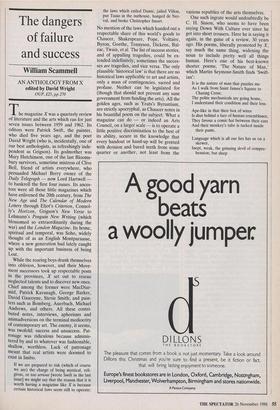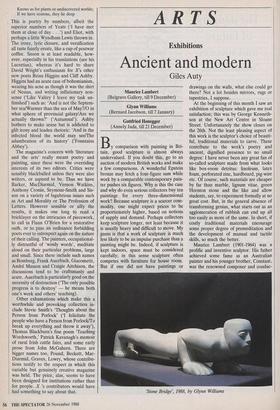The dangers of failure and success
William Scammell
AN ANTHOLOGY FROM X edited by David Wright OUP, f25, pp.270 The magazine X was a quarterly review of literature and the arts which ran for just seven issues between 1959 and 1962. Its editors were Patrick Swift, the painter, who died five years ago, and the poet David Wright (who is, incidentally, one of our best anthologists, as refreshingly inde- pendent as Grigson). Its godmother was Mary Hutchinson, one of the last Blooms- bury survivors, sometime mistress of Clive Bell, friend of artists everywhere, who persuaded Michael Berry owner of the Daily Telegraph — now Lord Hartwell to bankroll the first four issues. Its ances- tors were all those little magazines which have enlivened the 20th century, from The New Age and The Calendar of Modern Letters through Eliot's Criterion, Connol- ly's Horizon, Grigson's New Verse to Lehmann's Penguin New Writing (which blossomed so extraordinarily during the war) and the London Magazine. Its home, spiritual and temporal, was Soho, widely thought of as an English Montparnasse, where a new generation had lately caught up with the important business of being Lost.
While the roaring boys drank themselves into oblivion, however, and their Move- ment successors took up respectable posts in the provinces, X set out to rescue neglected talents and to discover new ones. Chief among the former were MacDiar- mid, Patrick Kavanagh, George Barker, David Gascoyne, Stevie Smith; and pain- ters such as Bomberg, Auerbach, Michael Andrews, and others. All these contri- buted notes, interviews, aphorisms and animadversions on the terminal mediocrity of contemporary art. The enemy, it seems, was twofold: success and unsuccess. Pat- ronage was ridiculous because adminis- tered by and to whatever was fashionable, shallow, worthless. Lack of patronage meant that real artists were doomed to exist in limbo.
If we are prepared to risk (which of course we are) the charge of being mystical, reli- gious, or too serious [wrote Swift in the last issue] we might say that the reason that it is worth having a magazine like X is because certain historical laws seem still to operate:
the laws which exiled Dante, jailed Villon, put Tasso in the nuthouse, hanged de Ner- val, and broke Christopher Smart.
No mention of the laws which handed out a respectable share of this world's goods to Chaucer, Shakespeare, Pope, Voltaire, Byron, Goethe, Tennyson, Dickens, Bal- zac, Twain, et al. The list of success stories, and of appalling tragedies, could be ex- tended indefinitely; sometimes the succes- ses are tragedies, and vice versa. The only plausible 'historical law' is that there are no historical laws applicable to art and artists, only a mass of contingencies, sacred and profane. Neither can be legislated for (though that should not prevent any sane government from funding the arts). All the golden ages, such as Yeats's Byzantium, are strictly apocryphal, as Chaucer notes in his beautiful poem on the subject. What a magazine can do — or indeed an Arts Council, on a larger scale — is to operate a little positive discrimination to the best of its ability, secure in the knowledge that every handout or hand-up will be greeted with derision and bared teeth from some quarter or another, not least from the various republics of the arts themselves.
One such ingrate would undoubtedly be C. H. Sisson, who seems to have been saying Down With Culture ever since he got into short trousers. Here he is saying it again, in the guise of a review, 30 years ago. His poems, liberally promoted by X, say much the same thing, widening the noun to include pretty well all things human. Here's one of his best-known shorter poems, 'The Nature of Man,' which Martin Seymour-Smith finds 'Swift- ian': It is the nature of man that puzzles me As I walk from Saint James's Square to Charing Cross;
The polite mechanicals are going home, I understand their condition and their loss.
Ape-like in that their box of wires Is shut behind a face of human resemblance, They favour a comic hat between their ears And their monkey's tube is tucked inside their pants.
Language which is all our lies has us on a skewer, Inept, weak, the grinning devil of compre- hension; but sleep Knows us for plants or undiscovered worlds; If we have reasons, they lie deep
This is poetry by numbers, albeit the superior numbers of Yeats CI have met them at close of day . .') and Eliot, with perhaps a little Wyndham Lewis thrown in. The irony, lyric closure, and versification all taste faintly ersatz, like a cup of postwar coffee. Sisson is at least readable, how- ever, especially in his translations (see his Lucretius), whereas it's hard to share David Wright's enthusiasm for X's other new poets Brian Higgins and Cliff Ashby. Higgins had an acute case of bohemianism, wearing his acne as though it was the shirt of Nessus, and writing inflationary non- sense (`Like Val6ry I leave my task un- finished') such as: 'And is not the Septem- ber sea/Warmer than the sea of May?/0 in what sphere of provincial galaxy/Are we actually thrown?' (`Autumnal'). Ashby bothers to make sense but is addicted to glib irony and leaden rhetoric: 'And in the infected blood the world may see/The adumbration of its history' (`Fountains Abbey').
The magazine's concern with 'literature and the arts' really meant poetry and painting, since these were the overriding interests of its two editors. Critics were sensibly blackballed unless they were also writers, or aspired to be. Thus we have Barker, MacDiarmid, Vernon Watkins, Anthony Cronin, Seymour-Smith and Sis- son on a variety of lugubrious issues such as Art and Morality or The Profession of Letters. However sensible or silly the results, it makes one long to read a bricklayer on the intricacies of piecework, to call in Flann O'Brien for a restorative oath, or to pass an ordinance forbidding poets ever to introspect again on the nature of their calling. The painters, occupational- ly distrustful of `windy words', meditate aloud on their particular problems, large and small. Since these include such names as Bomberg, Frank Auerbach, Giacometti, Andre Masson and Craigie Aitchison, the discussions tend to be craftsmanly and acute. Auerbach is particularly good on the necessity of destruction (`The only possible progress is to destroy' — he means both one's work and others' teaching).
Other exhumations which make this a worthwhile and provoking collection in- clude Stevie Smith's 'Thoughts about the Person from Porlock' CI felicitate the people who have a Person from PorlockiTo break up everything and throw it away'), Thomas Blackburn's fine poem 'Teaching Wordsworth,' Patrick Kavanagh's memoir of rural Irish cattle fairs, and some early prose from John McGahern. There are bigger names too, Pound, Beckett, Mac- Diarmid, Graves, Lowry, whose contribu- tions testify to the respect in which this variable but genuinely creative magazine was held. The price, alas, seems to have been designed for institutions rather than for people. X 's contributors would have had something to say about that.











































































 Previous page
Previous page